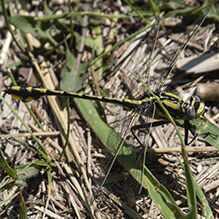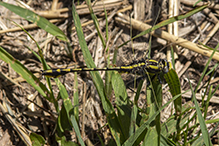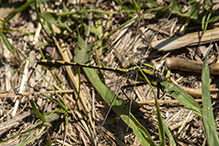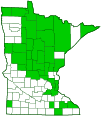pronghorn clubtail
(Phanogomphus graslinellus)
Conservation • Description • Habitat • Ecology • Distribution • Taxonomy
|
|
|||||||||||||
Description |
Pronghorn clubtail is a relatively robust, medium-sized dragonfly. It occurs mostly in central United States and southern Canada. In Minnesota it is most common in the central and north-central regions, less common in the metro and southeast regions, rare in the Arrowhead, and absent from the southwest. Adults are 1¾″ to 2 3⁄16″ (44 to 55 mm) long. The body is black with extensive yellow markings. The head is small. The face is greenish-yellow. The large compound eyes are blue or gray and do not meet at the top of the head. The area behind the compound eyes at the top of the head (occiput) on both sexes is yellow. The thorax is yellowish-green or greenish-yellow with several black stripes. The middle stripe on the upper side (middorsal stripe) is broad and has parallel sides. On each side there are two upper stripes (humeral and antehumeral stripes) that are partly fused together but separated in the middle by a thin pale stripe. The abdomen is slender and black with yellow markings. The upper (dorsal) surface of abdominal segments 1 through 7 have yellow, elongated, triangular spots. Segment 8 has a triangular spot at the base and sometimes a thin line extending from the triangle to the rear margin of the segment. Segment 9 has a broad stripe from the base top the rear margin. Segment 10 has a narrower stripe. Segments 7, 8, and 9 are expanded into a noticeable “club”. The sides of segments 8 and 9 have bright yellow along the entire margin. At the tip of segment 10 the male has a pair of distinctive, widely forked claspers (cerci). Each cercus has an outward-pointing “horn”, like a pronghorn antelope, for which this dragonfly gets its common name. The legs are dark brown to black. The third leg segment (femur) on the female is streaked with green, on the male it is entirely black. The upper (dorsal) surface of the fourth leg segment (tibia) on both sexes is yellow. The wings are clear except for a dark cell (stigma) on the leading edge near the tip. The vein on the leading edge (costa) of each wing is bright yellow. |
Size |
Total length: 1¾″ to 2 3⁄16″ (44 to 55 mm) |
Similar Species |
Habitat |
Ponds, lakes, and slow streams. |
Ecology |
Season |
Mid-May to mid-August |
Behavior |
|
Life Cycle |
|
Naiad Food |
|
Adult Food |
|
Distribution |
||
|
Sources Biodiversity occurrence data published by: Minnesota Biodiversity Atlas (accessed through the Minnesota Biodiversity Atlas Portal, bellatlas.umn.edu, 8/1/2025). Haarstad, J. 1997. The dragonflies of selected eastern Minnesota rivers. Report submitted to the Minnesota Department of Natural Resources. Unpaged. Steffens, W. P., and W. A. Smith. 1999. Status survey for special concern and endangered dragonflies of Minnesota: population status, inventory and monitoring recommendations. Final report submitted to the Natural Heritage and Nongame Research Program, Minnesota Department of Natural Resources. 54 pp. |
|
| 8/1/2025 | ||
Occurrence |
||
Common |
||
Taxonomy |
|
Order |
Odonata (Dragonflies and Damselflies) |
Suborder |
|
Superfamily |
Gomphoidea |
Family |
Gomphidae (clubtails) |
Genus |
Phanogomphus |
Superfamily Genus |
|
Subordinate Taxa |
|
|
|
Synonyms |
|
Gomphus graslinellus |
|
Common Names |
|
pronghorn clubtail |
|
Glossary
Cercus
One of a pair of small sensory appendages at the end of the abdomen of many insects and other arthropods. In Odonata, one of the upper claspers. Plural: cerci.
Costa
On ferns: The central axis of a pinna, to which pinnules are attached. On mosses: the central axis (midvein) of a leaf. On insects: The vein on the leading edge of the forewing.
Femur
On insects and arachnids, the third, largest, most robust segment of the leg, coming immediately before the tibia. On humans, the thigh bone
Occiput
The back of the head. In Odonata, Megaloptera, and Neuroptera, the upper part of the head behind the eyes.
Stigma
In plants, the portion of the female part of the flower that is receptive to pollen. In Lepidoptera, an area of specialized scent scales on the forewing of some skippers, hairstreaks, and moths. In other insects, a thickened, dark, or opaque cell on the leading edge of the wing.
Tibia
The fourth segment of an insect leg, after the femur and before the tarsus (foot). The fifth segment of a spider leg or palp. Plural: tibiae.
Visitor Photos |
||
Share your photo of this insect. |
||
This button not working for you? |
||
|
||
|
||
MinnesotaSeasons.com Photos |
||
 |
 |
|
 |

Slideshows |
|

Visitor Videos |
||
Share your video of this insect. |
||
This button not working for you? |
||
|
Other Videos |
||
Clubtail Dragonfly (Gomphidae: Gomphus) Waiting for Prey |
About
Jun 13, 2012 Photographed at the Turtle River State Park, North Dakota (12 June 2012). Either a female Gomphus graslinellus or a Gomphus exilis, I think. |
Pronghorn Clubtail |
About
Jun 20, 2015 Silver Springs SP, Yorkville, IL |

Visitor Sightings |
||
Report a sighting of this insect. |
||
This button not working for you? |
||
|
|
MinnesotaSeasons.com Sightings |
||

Created: 7/17/2020 Last Updated: © MinnesotaSeasons.com. All rights reserved. |
